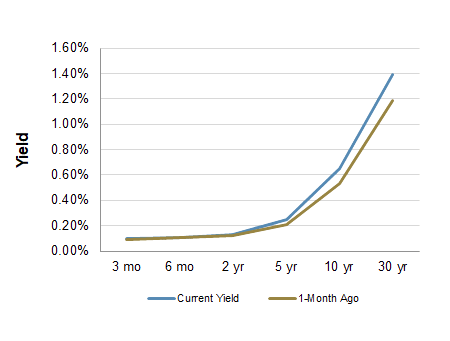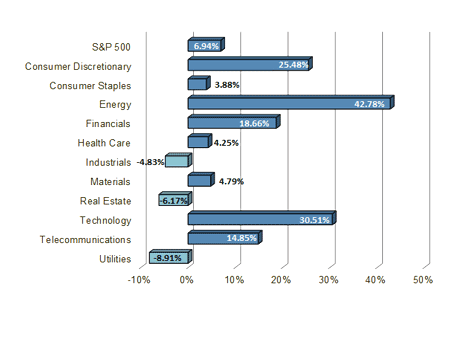Chief Economist Scott Brown discusses the latest market data.
While there were a number of important economic releases, market participants ignored the data for the most part. Tech highfliers came down, leading stock market indices lower.
Nonfarm payrolls rose by 1.371 million in the initial estimate for August, about as expected, boosted partly by a 251,000 increase in temporary hiring for the census. Payrolls are still down 11.5 million (7.6%) from February. The unemployment rate fell to 8.4% (from 10.2%), even as labor force participation improved. That’s good news. However, because many laid off workers exited the labor force earlier in the pandemic, the unemployment rate understates the weakness in labor market conditions. If labor force growth had remained on its pre-pandemic trend, the unemployment rate would be reported at 10.7% (down from 13.0% in July and 19.0% in April).
The ISM Manufacturing Index rose to 56.0 in August, vs. 54.2 in July, reflecting stronger growth in new orders and production. The ISM Services Index (formerly known as the Non-Manufacturing Index) edged down to 56.9 in August (from 58.1 in July). Business activity and new orders continued to advance, but slower than in July. Both surveys showed price pressures from supply chain disruptions and weakness in jobs. Jobless claims totaled 881,000 in the week ending August 29 (still extremely high), as the Labor Department shifted to an additive seasonal adjustment. The Fed’s Beige Book noted increased economic activity, “but gains were generally modest and activity remained well below levels prior to the pandemic.” The merchandise trade deficit hit a record high in July. Exports were hit harder than imports earlier in the pandemic and have been slower to recover in the initial rebound.
Next week, the economic calendar thins. Jobless claims, with the new seasonal adjustment, are expected to remain elevated. The PPI and CPI reports are expected to show a further rebound in prices that were depressed in March and April, some supply chain pressures, but no broad-based trend in underlying inflation.
Indices
| Last | Last Week | YTD return % | |
|---|---|---|---|
| DJIA | 28292.73 | 28492.27 | -0.86% |
| NASDAQ | 11458.10 | 11625.34 | 27.70% |
| S&P 500 | 3455.06 | 3484.55 | 6.94% |
| MSCI EAFE | 1899.02 | 1902.25 | -6.77% |
| Russell 2000 | 1544.68 | 1564.56 | -7.42% |
Consumer Money Rates
| Last | 1 year ago | |
|---|---|---|
| Prime Rate | 3.25 | 5.25 |
| Fed Funds | 0.08 | 2.11 |
| 30-year mortgage | 2.85 | 3.57 |
Currencies
| Last | 1 year ago | |
|---|---|---|
| Dollars per British Pound | 1.3281 | 1.225 |
| Dollars per Euro | 1.1852 | 1.014 |
| Japanese Yen per Dollar | 106.19 | 106.39 |
| Canadian Dollars per Dollar | 1.313 | 1.322 |
| Mexican Peso per Dollar | 21.652 | 19.721 |
Commodities
| Last | 1 year ago | |
|---|---|---|
| Crude Oil | 41.37 | 56.26 |
| Gold | 1937.80 | 1560.40 |
Bond Rates
| Last | 1 month ago | |
|---|---|---|
| 2-year treasury | 0.13 | 0.12 |
| 10-year treasury | 0.65 | 0.53 |
| 10-year municipal (TEY) | 1.25 | 0.88 |
Treasury Yield Curve – 08/28/2020

As of close of business 09/03/2020
S&P Sector Performance (YTD) – 09/04/2020

Economic Calendar
| September 7 | — | Labor Day Holiday (markets closed) |
| September 11 | — | Jobless Claims (week ending September 5) |
| — | Producer Price Index (August) | |
| September 11 | — | Consumer Price Index (August) |
| September 15 | — | Industrial Production (August) |
| September 16 | — | Retail Sales (August) |
| — | FOMC Policy Decision | |
| October 29 | — | Real GDP (3Q20, advance estimate) |
| November 3 | — | Election Day |
| November 5 | — | FOMC Policy Decision |
All expressions of opinion reflect the judgment of the Research Department of Raymond James & Associates, Inc. and are subject to change. There is no assurance any of the forecasts mentioned will occur or that any trends mentioned will continue in the future. Investing involves risks including the possible loss of capital. Past performance is not a guarantee of future results. International investing is subject to additional risks such as currency fluctuations, different financial accounting standards by country, and possible political and economic risks, which may be greater in emerging markets. While interest on municipal bonds is generally exempt from federal income tax, it may be subject to the federal alternative minimum tax, and state or local taxes. In addition, certain municipal bonds (such as Build America Bonds) are issued without a federal tax exemption, which subjects the related interest income to federal income tax. Municipal bonds may be subject to capital gains taxes if sold or redeemed at a profit. Taxable Equivalent Yield (TEY) assumes a 35% tax rate.
The Dow Jones Industrial Average is an unmanaged index of 30 widely held stocks. The NASDAQ Composite Index is an unmanaged index of all common stocks listed on the NASDAQ National Stock Market. The S&P 500 is an unmanaged index of 500 widely held stocks. The MSCI EAFE (Europe, Australia, Far East) index is an unmanaged index that is generally considered representative of the international stock market. The Russell 2000 index is an unmanaged index of small cap securities which generally involve greater risks. An investment cannot be made directly in these indexes. The performance noted does not include fees or charges, which would reduce an investor’s returns. U.S. government bonds and treasury bills are guaranteed by the US government and, if held to maturity, offer a fixed rate of return and guaranteed principal value. U.S. government bonds are issued and guaranteed as to the timely payment of principal and interest by the federal government. Treasury bills are certificates reflecting short-term (less than one year) obligations of the U.S. government.
Commodities trading is generally considered speculative because of the significant potential for investment loss. Markets for commodities are likely to be volatile and there may be sharp price fluctuations even during periods when prices overall are rising. Specific sector investing can be subject to different and greater risks than more diversified investments. Gross Domestic Product (GDP) is the annual total market value of all final goods and services produced domestically by the U.S. The federal funds rate (“Fed Funds”) is the interest rate at which banks and credit unions lend reserve balances to other depository institutions overnight. The prime rate is the underlying index for most credit cards, home equity loans and lines of credit, auto loans, and personal loans. Material prepared by Raymond James for use by financial advisors. Data source: Bloomberg, as of close of business September 3, 2020.
Markets & Investing Members of the Raymond James Investment Strategy Committee share their views on...
Markets & Investing Review the latest Weekly Headings by CIO Larry Adam. Key Takeaways ...
Technology & Innovation Learn about a few simple things you can do to protect your personal information...